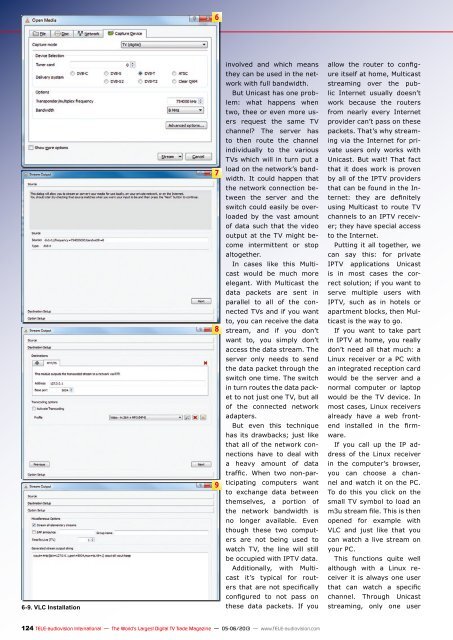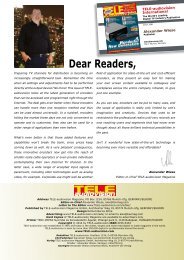eng TELE-audiovision 1305
The World’s Largest Digital TV Trade Magazine
The World’s Largest Digital TV Trade Magazine
Create successful ePaper yourself
Turn your PDF publications into a flip-book with our unique Google optimized e-Paper software.
6-9. vLc Installation<br />
124 <strong>TELE</strong>-<strong>audiovision</strong> International — The World‘s Largest Digital TV Trade Magazine — 05-06/2013 — www.<strong>TELE</strong>-<strong>audiovision</strong>.com<br />
6<br />
7<br />
8<br />
9<br />
involved and which means<br />
they can be used in the network<br />
with full bandwidth.<br />
But Unicast has one problem:<br />
what happens when<br />
two, thee or even more users<br />
request the same TV<br />
channel? The server has<br />
to then route the channel<br />
individually to the various<br />
TVs which will in turn put a<br />
load on the network’s bandwidth.<br />
It could happen that<br />
the network connection between<br />
the server and the<br />
switch could easily be overloaded<br />
by the vast amount<br />
of data such that the video<br />
output at the TV might become<br />
intermittent or stop<br />
altogether.<br />
In cases like this Multicast<br />
would be much more<br />
elegant. With Multicast the<br />
data packets are sent in<br />
parallel to all of the connected<br />
TVs and if you want<br />
to, you can receive the data<br />
stream, and if you don’t<br />
want to, you simply don’t<br />
access the data stream. The<br />
server only needs to send<br />
the data packet through the<br />
switch one time. The switch<br />
in turn routes the data packet<br />
to not just one TV, but all<br />
of the connected network<br />
adapters.<br />
But even this technique<br />
has its drawbacks; just like<br />
that all of the network connections<br />
have to deal with<br />
a heavy amount of data<br />
traffic. When two non-participating<br />
computers want<br />
to exchange data between<br />
themselves, a portion of<br />
the network bandwidth is<br />
no longer available. Even<br />
though these two computers<br />
are not being used to<br />
watch TV, the line will still<br />
be occupied with IPTV data.<br />
Additionally, with Multicast<br />
it’s typical for routers<br />
that are not specifically<br />
configured to not pass on<br />
these data packets. If you<br />
allow the router to configure<br />
itself at home, Multicast<br />
streaming over the public<br />
Internet usually doesn’t<br />
work because the routers<br />
from nearly every Internet<br />
provider can’t pass on these<br />
packets. That’s why streaming<br />
via the Internet for private<br />
users only works with<br />
Unicast. But wait! That fact<br />
that it does work is proven<br />
by all of the IPTV providers<br />
that can be found in the Internet:<br />
they are definitely<br />
using Multicast to route TV<br />
channels to an IPTV receiver;<br />
they have special access<br />
to the Internet.<br />
Putting it all together, we<br />
can say this: for private<br />
IPTV applications Unicast<br />
is in most cases the correct<br />
solution; if you want to<br />
serve multiple users with<br />
IPTV, such as in hotels or<br />
apartment blocks, then Multicast<br />
is the way to go.<br />
If you want to take part<br />
in IPTV at home, you really<br />
don’t need all that much: a<br />
Linux receiver or a PC with<br />
an integrated reception card<br />
would be the server and a<br />
normal computer or laptop<br />
would be the TV device. In<br />
most cases, Linux receivers<br />
already have a web frontend<br />
installed in the firmware.<br />
If you call up the IP address<br />
of the Linux receiver<br />
in the computer’s browser,<br />
you can choose a channel<br />
and watch it on the PC.<br />
To do this you click on the<br />
small TV symbol to load an<br />
m3u stream file. This is then<br />
opened for example with<br />
VLC and just like that you<br />
can watch a live stream on<br />
your PC.<br />
This functions quite well<br />
although with a Linux receiver<br />
it is always one user<br />
that can watch a specific<br />
channel. Through Unicast<br />
streaming, only one user


















